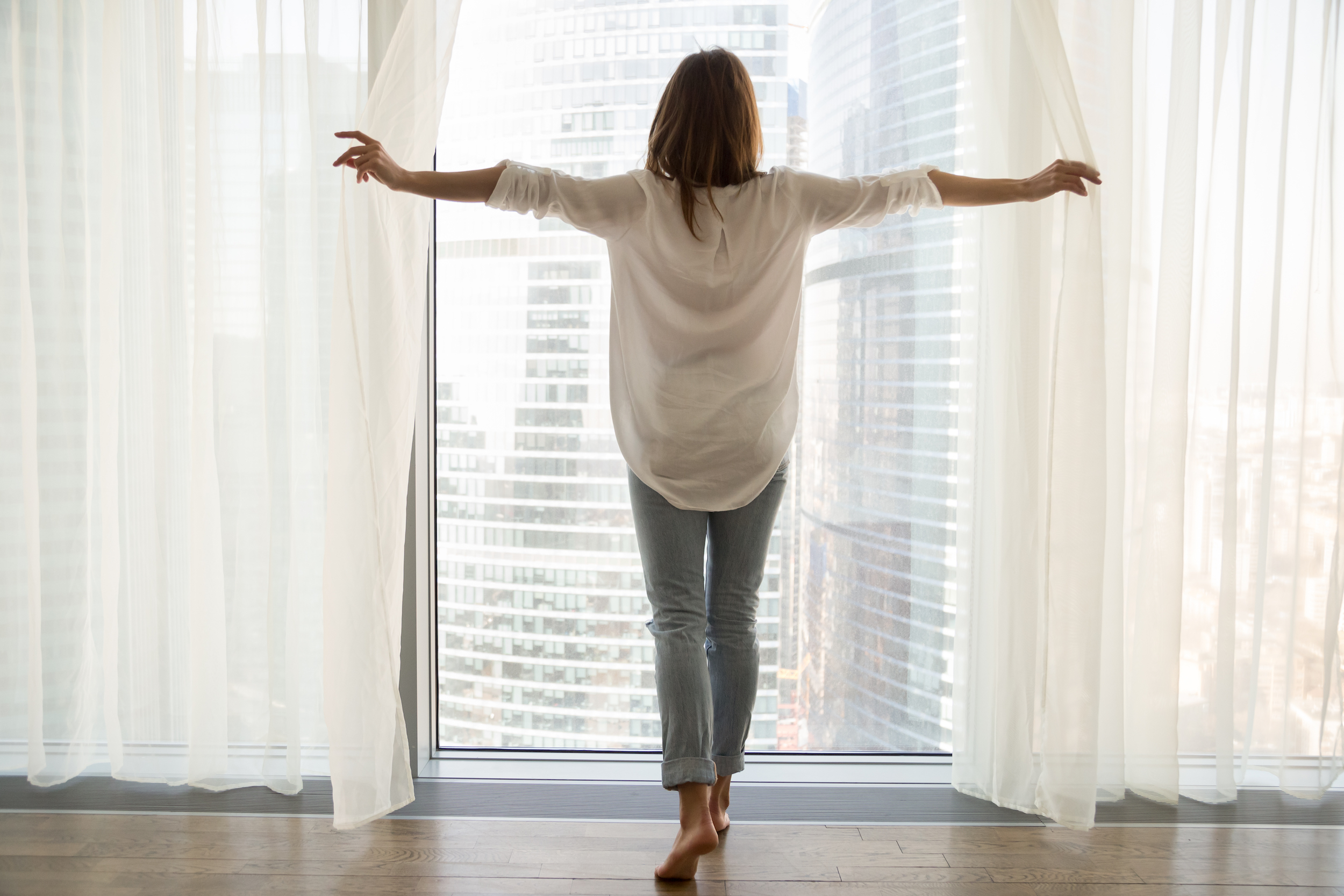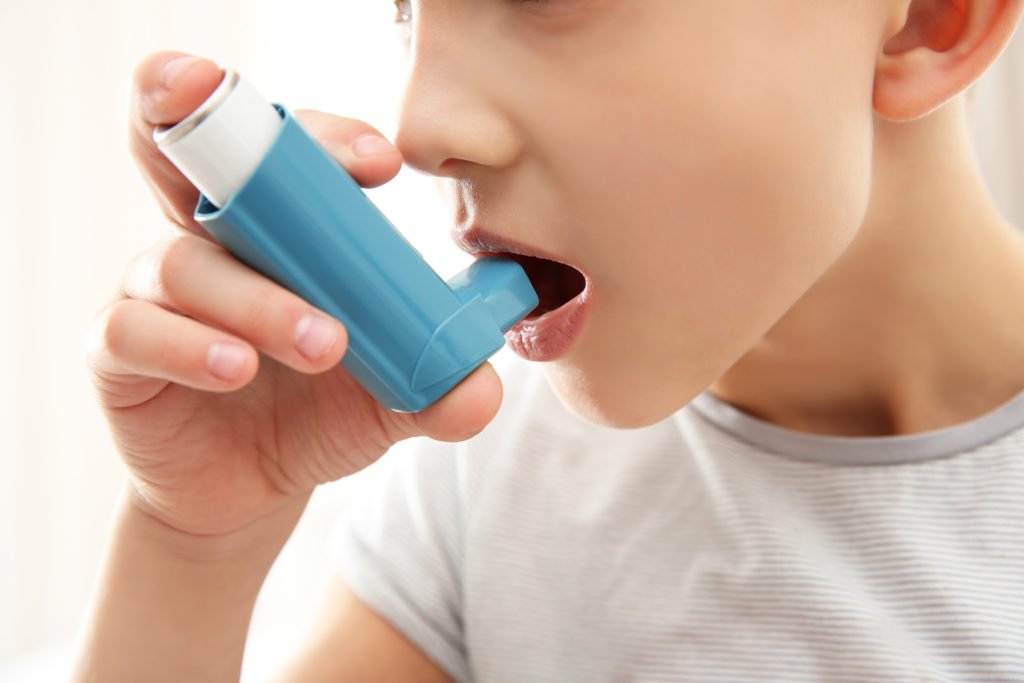
Inside This Post: Cleaning up the air inside your home to improve air quality and get rid of pollutants and chemicals. How to clean up the air in your home in 6 easy steps.
This post may contain affiliate links. You can see my disclosure policy here.
Cleaning Up the Air In Your Home in 6 Steps
Americans spend the majority of their time inside their homes – cooking, sleeping, eating, and being with your family – but did you know that studies report indoor air is 10x more toxic than outdoor air?
It’s because microbial pollutants such as mold, pollen, pet dander, and the ozone combine with dangerous chemicals like radon and volatile organic compounds (VOCs) from products in your home to create a pretty toxic environment.
Here’s another shocking statistic that people who work from home and stay at home parents are 54% more likely to get cancer because of their exposure to chemicals, than those who aren’t at home all day.
When you spend 90% of your time indoors, it’s fair to say this is the place where you spend the vast majority of your breathing. That’s why it’s essential the air quality inside your home is clean, safe and free from chemicals so it doesn’t impact your health.
It’s important to take steps to clean up the air in your home.
Why Is Your Home Full of Pollutants and Your Indoor Air Polluted?
The list of toxic items in your house is literally, a mile long but the biggest offenders to indoor polluted air includes:
- Off-gassing from furniture
- Fire retardants
- Perfumes
- Scented candles and air fresheners
- Chemicals in cleaning products
- Chemicals from synthetic clothes and materials (carpet, rugs, furniture)
- Clothes from the dry cleaners
- Stagnant air
All the chemicals from products and pieces inside your home can have adverse reactions such as asthma and respiratory symptoms, allergies, and in some cases, cancer.
When you’re outside, the air is constantly moving, it’s not stagnant like inside your home if you rarely open the windows and let a breeze in. Outside air doesn’t sit and collect pollutants in one spot.
You can’t just open your windows and think your air cleaner, you have clean the air and make changes for cleaner, healthier and safer air for your family to breathe.
A Guide to Cleaning Up The Air Inside Your Home – 7 Easy Steps
1. Let Fresh Air in
The most natural and simplest way to start cleaning the air in your home is by cracking the window open and letting the outdoor air in to circulate through your home.
Opening the window and letting fresh air circulate, even if it’s just a small crack in the window during the winter and cold nights, allows polluted air to make it’s way outside, instead of being stagnant inside.
On cold days, opening up windows on each floor for even 5 minutes gets rid of the build up of toxins in the air. Plus, it clears the air of smells, and naturally makes your home smell better.

2. Don’t Wear Shoes in the House
Each day you walk over pavement, dirt, in oil on the ground, pesticide-sprayed grass, lead paint, gasoline and other surfaces with industrial contaminants.
It’s a simple step to make everyone leave their shoes at the door and helping contain pollutants outside, in your garage or mud room, without tracking all the contaminants inside your home.
Designate a dropping spot near a door or outside in the garage where shoes get taken off, and put on when it’s time to go.
According to the Environmental Protection Agency, lead in soil can be ingested as a result of hand-to-mouth activity and that is common for young children. According to the Centers for Disease Control, there is no safe level of lead for children.
If you have little ones crawling on the floor and you still wear shoes in the house, you could be tracking lead in soil into your home and then they transfer it into their mouths. Yuck!
If you need something on your feet at all times, consider buying a comfortable pair of house slippers you only wear indoors and never outside.
3. Get Rid of Volatile Compounds (Candles, Air Fresheners, Perfumes, etc.)
Do you have candles, or cans of air freshener, plug-in Glade or Febreeze in your home? Toss it, right now.
Volatile organic compounds (VOCs) are chemicals emitted by gasses in certain solids and liquids and have adverse effects. VOCs mix with the ozone inside your home to create smog.
The EPA found that VOC concentrations in homes are 2 to 5 times higher than outside, regardless of what kind of area you live in.
VOCs are widely used in a lot of household products like cleaning products, paint, perfume, air sprays and air fresheners of several types, perfume, and cosmetics. Some are known to cancer as well as irritation to eyes and nose.
If you want to improve the air quality inside your home, it’s important to eliminate VOCs in your home.
Here’s what to avoid:
- Glade plug-ins
- Bathroom deodorizers
- Scented Yankee candles and many other kinds of candles
- Febreeze
- Perfumes
- Anything with a synthetic perfume smell
If you need help monitoring the inside of your home for toxic VOCs you can get a little gadget to monitor your air quality that hooks up to your mobile device.
Choosing natural cleaning products help greatly to cut down on toxic VOC exposure in your home. I’ve checked out a toooon of cleaning products and finally landed on this completely green, plant-based and chemical free cleaning line for my whole home.
I’ve been really impressed that I can use the basic cleaner for everything – mirrors, stainless steel, counters, toilets, bathrooms, floors and as a degreaser.
4. Load Up with House Plants
NASA’s study of beneficial plants for your indoor air quality (PDF) can help eliminate chemicals like formaldehyde in your home, and bring clean oxygen in. Air cleaning plants can literally clean the air for you and don’t need any help but occasional watering and light.
15 Best Plants to Clean Indoor Air
- Philodendron Scandens Oxycardium; Heartleaf Philodendron
- Philodendron Domesticum; Elephant Ear Philodendron
- Dracaena Fragrans varieties: Massangeana, Janet Craig and Warneckii
- Hedera Helix; English Ivy
- Chlorophytum Comosum; Spider Plant
- Ficus Benjamina; Weeping Fig
- Epipiremnum Aureum; Golden Pothos
- Spathiphyllum Wallisii; Mauna Loa Peace Lily
- Philodendron Bipinnatifidum; Selloum Philodendron
- Aglaonema Modestum; Chinese evergreen
- Chamaedorea Sefritzii; Bamboo or Reed Palm
- Sansevieria Trifasciata; Snake Plant or Mother In Law’s Tongue
- Dracaena Marginata; Red-edged Dracaena
- Gerbera Jamesonii; Gerbera Daisy
- Chrysanthemum Morifolium; Pot Mum
The study recommends 15 plants in a 2,000 square foot home, and most of them can be found easily at a plant nursery but I love to get mine at Home Depot.
5. Clean Up the Dust
When dust accumulates in your home – it builds up with fine particles, lead dust, pollutants, dander and hair – which trigger allergies, irritation and even illness.
The accumulation of these pollutants in your home compound and make them even more toxic.
Not that you want another thing to do, but it’s important to dust and sweep regularly including those easily forgotten spots like ceiling fan blades, tops of shelves, electronic equipment, the top of the fridge, blinds and curtains and the top of door frames.
It’s a good investment to have a vacuum with a HEPA filter to trap dust, danger, and pollutants and keep the air inside your home clean. I love our Shark Navigator and is has a HEPA filter.
Also, change your home’s air filter and furnace filter every other month, and get your air conditioner cleaned for better ventilation. Use HEPA filters to trap more pollutants so they don’t circulate in your home’s air.
I like to slip these into our air vent filters into the registers around our home to help keep air clean as well.

6. Look Into Home Air Filters
There are several types of portable air filters you can have in your home, and move from room to room. HEPA air filters are portable so you can clean the air in every room of your home.
HEPA Air Filters
Pros: HEPA stands for High-Efficiency Particulate Air. These filters meet the Department of Energy requirements for the removal of about 99.97% of the particulates from the air and air pollutants; dust mites, pet dander, pollen and other allergens as small as 0.3 microns.
If you are aiming to remove mold spores, flame retardants, dust pollen, bacteria or pet dander, this may be a good option. But the one thing they may not be able to capture is viruses, which are smaller than bacteria.
Cons: HEPA may not be able to trap gases, fumes or other chemicals and odors. It also has problems capturing viruses. In order to trap all those things, you’ll need a disinfecting filtration system instead.
Best Choices: Winix 5300-2 Air Purifier, AeraMax Air Purifer, Alen BreatheSmart FLEX Air Purifier